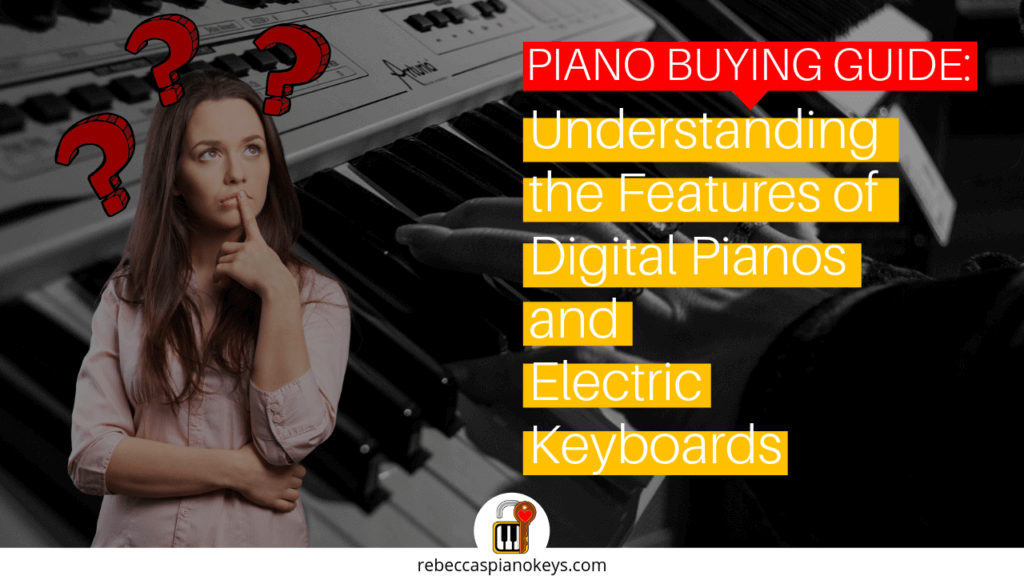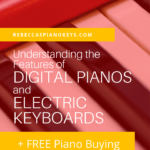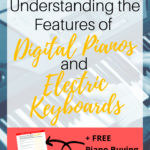Last Updated on September 12, 2021 by Rebecca
*I am not an affiliate for any of the brands/companies/products mentioned in this post. This post is for information purposes only!
If you're still not sure whether you should be buying a digital piano, an electric keyboard, or an acoustic piano, you'll want to head over to my previous post and learn the advantages and disadvantages of each type of piano.
But if you already know an acoustic piano isn't right for you at this time, and you're ready to go out and buy either a digital piano or an electric keyboard, this post is for you!
Deciding what piano to buy can be a daunting experience, especially if you're not sure what's best for you. It's a big investment!
But now you've started shopping around for digital pianos and electric keyboards, you're overwhelmed by a bunch of features that you don't really understand, you don't know which ones are important and which ones aren't… and you're suffering a bit of overwhelm.
It's a big investment, so trying to make the right buying decision when you don't feel like you truly understand what's what can be a very daunting experience.
But don't worry! I got you! 🙂
In this post, I'll explain everything you need to know so you can make an informed decision and buy the best piano to suit your needs!
No more overwhelm!
By the time I'm done with you, you'll know exactly what you personally should or should not be looking for in each of the following categories:
- Size
- Polyphony
- Weighted Keys
- Touch-Sensitive Keys
- Damper Pedal
- Piano Stand and Bench
- Music Stand
- Speakers
I'll also give you some recommendations for brands, and I'll even throw in a free shopping cheat sheet that you can fill in according to your individual needs.
Now let's get started!
(No time to read now? Pin it for later!)

1) Size
Digital pianos are meant to mimic acoustic pianos, so they have a full keyboard of 88-piano keys.
Electric keyboards come in various sizes. Some with the full 88-keys, and others with less.
Ultimately, it's up to you to decide how many keys you want.
Fewer keys generally equates to a smaller price tag. And smaller instruments are more portable.
However, fewer keys also means you have less musical range available to you. I have a 61-key midi controller, and it drives me crazy not having access to all of the notes I want to use in my music.
How to Choose the Right Size for You
As a beginner, you can definitely start with a smaller keyboard (I wouldn't recommend anything smaller than 61 keys as your primary instrument), but be aware that as you progress in your music education, you will outgrow your smaller keyboard relatively quickly.
Of course, if your aim is to get a small instrument that you can throw in a backpack and take with you to a rooftop, a cafe, or a beach and have some fun, then by all means, go for something real small!
Belle Chen is one of my favourite pianists on Instagram (I have several favourites!), and recently she has posted several video clips of herself playing very cool music in all kinds of cool places. Check out one example below:
I won't lie, she's got me wanting to try it too!
That being said, I wouldn't recommend this mini keyboard (or any mini keyboard) for a beginning piano player. The keys are smaller than those on a standard piano, and when you're just starting out, it's really important that you have an instrument with standard-sized keys so that your hands and fingers can develop a sense of “intuition” for where the keys are.
2) Polyphony
Polyphony refers to the number of different sounds your keyboard can create simultaneously.
If you want to be able to do any of the following things, you'll need polyphony:
- Play chords
- Play a melody with chords for harmony
- Use a damper/sustain pedal to have the notes you play linger as you move onto new notes
- Have a built-in metronome playing while you play
- Play with a built-in backing track
- Create and record tracks for layering
- Play very fast runs of notes (ex: fast scales, glissandos, etc.)
- Have the notes you play sound in stereo (which is standard) instead of mono
As you can see, polyphony is about a lot more than just being able to play a couple notes at the same time!
Quality digital pianos and electric keyboards can have up to 256-key polyphony. (If you've seen any with more, let me know in the comments!) On the low end, 128-key polyphony is the generally accepted minimum for a decent instrument.
How to Choose the Right Polyphony for You
For a beginner, I recommend 128-key polyphony as a good place to start.
An instrument with 128-key polyphony will keep you happy for a long time. One of my digital pianos has 128-key polyphony, and I do just fine with it.
You could possibly get by on an instrument with less than 128-key polyphony, but I don't see why you would want to. Electric keyboards with 128-key polyphony are easy to find, and relatively inexpensive.

3) Weighted Keys
Weighted keys will have more of a “real piano” feel to them when you play them. They will offer some resistance when you play them, as a way of trying to emulate the feel of an acoustic piano. But be careful because not all weighted keys are created equal!
There are 4 main categories when it comes to key weighting: non-weighted, semi-weighted, hammer action, and graded weighting (aka graded hammer action).
Non-weighted Keys
Non-weighted keys are common on MIDI keyboards and also on cheap keyboards for beginners.
Semi-weighted Keys
Semi-weighted keys won't offer the same resistance as an acoustic piano, but they will have a bit more of a natural feel than a non-weighted keyboard.
Hammer Action Keyboard
Hammer action keyboards are intended to offer resistance that replicates the feel of an acoustic piano (although some are better than others). Each key on the keyboard is weighted equally.
Graded Weighting/Graded Hammer Action
Graded weighting, (also called graded hammer action), takes it one step further to really attempt to mimic the feel of an acoustic piano. On acoustic pianos (especially high quality ones) the lower keys offer a lot more resistance than the higher keys. A digital piano or electric keyboard with graded weighting attempts to replicate this.
How to Choose the Right Key Weighting for You
You'll have to decide for yourself what level of weighting you prefer, but there are a few things you'll want to consider when deciding.
If your top priority is either portability or a tight budget, you'll want to go with non-weighted or semi-weighted.
You'll want hammer action or graded hammer action if you also want to use your skills to play on an acoustic piano. When you play on an acoustic piano, you develop the finger strength necessary to match the resistance offered by the keys. If you learn on a keyboard with non-weighted keys, you won't develop this finger strength, which will make playing on an acoustic piano somewhat uncomfortable and disorienting for you.
Also, weighted keys will allow you to develop better articulation, expressiveness, and technique in your playing.
But even these guidelines are not as informative as you might hope because every instrument feels different, even if they say they have the same kind of weighting. So the best thing to do (if you are able to) is to go to a music store and play around on their pianos so you can decide what feels best to you.
In my previous post Piano Buying Guide: How to Choose the Right Piano for YOU, I mention that I don't really like the weighting on my Casio Privia. I wish the keys offered more resistance. If I had tried this instrument in a store first, I never would have bought it. Unfortunately, I ordered it online, so I had no way of knowing until it was too late.
4) Touch-Sensitive Keys
For the love of … chocolate cake… please buy an instrument with touch-sensitive keys!
Having touch sensitive keys means that when you depress a key using a heavier touch, you get a louder sound, and when you depress a key using a softer touch, you get a softer sound.
You'd be surprised how devastating it can be to try and create music without touch-sensitive keys.
Do you want to play with expressive dynamics? Soft, delicate parts, loud dramatic parts, and everything in between? You can't do that without touch-sensitive keys.
Do you want to play a melody in your right hand with chords in the left hand for harmony to make the music sound rich, full, and impressive? When we do this, we play the left-hand chords softer than the right-hand melody so the melody shines through. Without touch-sensitive keys, you can't do this and the chords will overpower the melody.
How to Choose the Right Touch-Sensitivity for You
Basically, if you want your music to sound good, you need touch-sensitive keys. Without touch-sensitive keys, your music will sound robotic.
5) Damper Pedal
The damper pedal is also called the sustain pedal. What it does is allows the sounds you play to linger even after you've moved on to new notes. It creates a beautiful echoing effect that makes your music sound soft and flowy. (But don't think it's only for soft music… it sounds spectacular in big, dramatic music too!)
It's also really helpful if you want to incorporate bit leaps in your left hand without it sounding disjointed.
Believe me when I say… learning to play with the damper pedal is every new piano student's favourite thing ever!
But not all keyboard and digital pianos come with pedals!
If the model you're looking at doesn't come with one, you'll want to find out whether it's compatible with detachable pedals that you can purchase separately. You'll also want to consider the additional expense of purchasing a pedal separately (would a more expensive keyboard that comes with one ultimately prove to be cheaper?).
How to Choose the Right Pedal Setup for You
When it comes right down to it, a damper pedal is not strictly necessary and you can definitely get by without one. But you'll really be disappointing yourself if you don't get one.
6) Piano Stand and Bench
Whatever you do, make sure you get a stand and bench with your piano (unless you're getting a mini keyboard to take to the beach!). Proper form and posture is incredibly important for ease of playing and also to avoid injuries.
You don't want to sit on the couch with your keyboard in your lap, or on a bed with your keyboard in front of you, or even at a desk or table with the keyboard on top of it. All of these situations are less than ideal, and honestly, I would find them incredibly uncomfortable (not to mention limiting!).
Most (but not all!) digital pianos come with a very solid stand and bench that make them look almost like acoustic pianos. They'll look nice and classy in your home.
Most electric keyboards (and digital stage pianos intended for gigging) do not come with a stand and require you to buy one separately. In this case, you'd want to find a good, solid X frame. These are great because they are easily adjustable and you can also fold them up to take them with you wherever you are taking your keyboard.
If your instrument doesn't come with a stand, it also won't come with a bench, so you'll have to shop around and find one. There are lots of options, fixed 4-legged benches, adjustable 4-legged benches, and adjustable X-frame benches.
How to Choose the Right Stand for You
First of all, decide whether you need a stand and bench. You can make do without out, but I advise against this. The only time I would recommend not using one is if you're buying a mini keyboard to take on roadtrips, or a MIDI controller to use as an input device with your computer.
“I just want to put my piano on my coffee table or my lap and sit on my couch” and “I'm planning to play my piano sitting in bed” are not acceptable answers! Just don't do this to yourself. You won't be able to play effectively in these positions, you'll injure your back, and depending how you sit, you could also cause some serious carpal tunnel issues in your wrists.
Second, decide which kind of stand you want, based on how you will be using your instrument.
An X-frame is the best choice if you are planning to move your piano around a lot (like for gigs and performances). It's also the best kind of frame for people who prefer to play piano standing up, and therefore need to their piano adjusted higher than the standard height.
A full-bodied, built-in stand is what you want if you want your piano to look like a classy piece of furniture in your home, and don't intend to move it around much.
How to Choose the Right Bench for You
Again, your first step is to decide whether you need a bench at all. For most people, you need a bench. The only times you don't need a bench are if you are buying a mini-keyboard or a midi controller (for the same reasons mentioned above), or if you are someone who prefers to play standing up.
Second, decide which type of bench is best for you.
If you're going for the “classy piece of furniture” look, you'll want a traditional 4-legged bench.
If you need your instrument to be portable, you'll appreciate an X-frame bench.
In terms of adjustability, most adults will find a standard fixed bench meets their needs just fine. If you know you are very tall or very short, or if you know you will have children playing your piano as well, you will appreciate an adjustable bench.
7) Music Stand
You know that stand where people put their sheet music so they can look at it while they play piano?
Believe it or not, not all keyboards and digital pianos come with this!
And buying them separately can be expensive. In his video Is It Okay To Practice On a Digital Piano?, Josh Wright says he spent $130 on a music stand for his Nord keyboard! (!!!)
I've never had to buy a music stand separately because I've always made sure to buy an instrument that comes with one, so I have no idea if that is a standard price point. But $130 seems like a lot of money for a music stand if you ask me!
How to Choose the Right Music Stand for You
If you're never planning to read sheet music, you may not need a music stand at all.
If you do want a music stand, my personal opinion is that it's much easier to just buy an instrument that comes with one. If your instrument doesn't come with one, make sure you find one that is compatible with your instrument, and make sure you take the extra cost into consideration before making your final decision.
8) Speakers
Don't assume a digital piano or electric keyboard will come with built-in speakers! Some, especially MIDI controllers and stage keyboards, are designed to be hooked up to an external sound system.
How to Choose the Right Speaker System for You
If you're planning to take your keyboard out gigging with a band, you will likely want one that is designed to hook up to an external sound system.
If you're planning to play in your living room, you would likely find dealing with an external sound system annoying and would prefer an instrument with built-in speakers.
Selecting a Brand of Electric Keyboard or Digital Piano
When shopping for digital pianos and electric keyboards, you really can't go wrong with a Yamaha, a Roland, or a Nord.
If you dream of playing at the beach or on the train like Belle Chen, the mini keyboard she was playing on is the Yamaha Reface CP. This video shows you a bit more of what it can do:
**Now remember, if you're just starting out and your goal is to learn how to play piano, I do not recommend this instrument! To me, this instrument is dessert, not dinner. And you eat dessert after dinner, not instead of!
Are You Ready to Start Shopping for Your Digital Piano or Electric Keyboard?
I've created a simple piano buying cheat sheet you can use to organize your thoughts so you can make sure you get the perfect digital piano or electric keyboard for you. The sheet lists the 8 simple questions you should ask yourself before you begin shopping, and provides space beside each where you can write the answers that are right for you.
Fill it in according to what your current priorities are, and compare piano models against your list to make sure you're getting exactly what you want and need.
Share Your Thoughts!
Have you ever bought a digital piano or electric keyboard, only to be disappointed once you started learning to use it? What do YOU think is the most important feature? What's the most helpful thing you've learned from this article? Did I miss any important details and leave you will any unanswered questions? Share your thoughts in the comments!
And remember, these share buttons are here for a reason! If you know someone who would benefit from the information in this post, be sure to share it with them!




